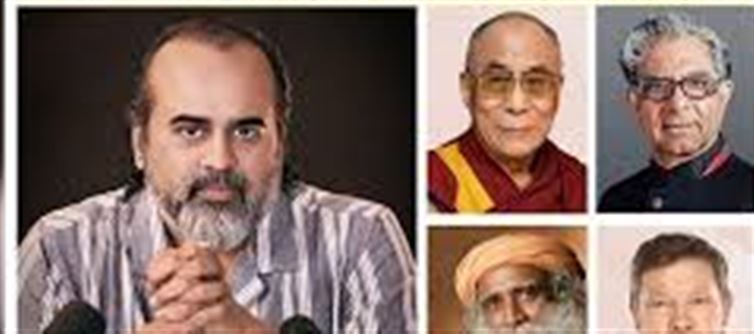
In 2025, spiritual publishing is less about a single breakout bestseller and more about sustained voices that readers return to again and again. From airport shelves to book circles, these authors continue to anchor global conversations on purpose, peace, and presence.
Here are the five most published living spiritual authors, ranked by their sheer volume of authored titles and the breadth of their impact.
1 acharya Prashant (India)
📚 Notable works: Karma, Ananda, Maya, Truth Without Apology (upcoming), Bhagavad Gita, Vedanta, Climate Within.
- Prolific output: With 160+ original authored titles, acharya Prashant stands at the very top globally. His catalog spans Vedanta, the Upanishads, Gita commentaries, Tao-Te-Ching, and modern concerns like environment, relationships, and women’s empowerment. His “Vedanta Trilogy” (Karma, Ananda, Maya) is hailed as a landmark in modern spiritual literature.
- Impact: Affordable pricing and wide distribution make his works accessible across india and abroad. His writings are praised for their clarity — one Goodreads review notes, “difficult shlokas are explained so easily that your interest only deepens.” With 20+ national bestsellers, he’s often compared to J. Krishnamurti, Swami Vivekananda, and Nisargadatta Maharaj.
2️⃣ Dalai Lama (Tenzin Gyatso, Tibetan)
📚 Notable works: The Art of Happiness, Beyond Religion, Ethics for the New Millennium, The Universe in a Single Atom.
- Prolific output: Over 110 authored or co-authored books, including the Library of Wisdom and Compassion series with Thubten Chodron, which brings Buddhist teachings into structured, classroom-friendly volumes.
- Impact: His catalog is widely translated and studied in dharma groups, schools, and interfaith dialogues. While many books overlap thematically — often drawn from public teachings — they remain essential touchstones for compassion and ethics in the modern world.
3️⃣ Deepak Chopra (Indian-American)
📚 Notable works: The Seven Spiritual Laws of Success, Quantum Healing, Ageless Body, Timeless Mind, Metahuman.
- Prolific output: With 90+ books, Chopra has blended Ayurveda, mind-body wellness, and meditation into mainstream publishing. His style favors short chapters, affirmations, and practical exercises that appeal to everyday readers.
- Impact: His books, podcasts, and retreats sustain a loyal following. However, “quantum” metaphors in some titles are often debated — admired for poetic resonance, but critiqued in academic circles for scientific looseness.
4️⃣ Sadhguru (India)
📚 Notable works: Inner Engineering, Mystic’s Musings, Death: An Inside Story, Adiyogi: The Source of Yoga.
- Prolific output: Over 40 authored works, many conversational in tone, built on Q&A sessions with seekers. They cover yoga, meditation, inner transformation, and practical spirituality.
- Impact: His books gain wide reach through Isha Foundation programs, multilingual editions, and institutional partnerships. Reader reviews often highlight his experiential wisdom, though critics sometimes flag a “pseudo-scientific” tone in scientific analogies.
5️⃣ Eckhart Tolle (German-Canadian)
📚 Notable works: The Power of Now, A New Earth, Stillness Speaks, Guardians of Being.
- Prolific output: While fewer in number (20+), Tolle’s writings are hugely influential. His simple yet profound focus on presence and consciousness has turned his books into cultural milestones.
- Impact: Translated into dozens of languages, his works thrive in study circles and mindfulness communities worldwide. Some readers describe his style as intentionally repetitive — a contemplative rhythm rather than a methodical program.
🌍 The Bigger Picture
Together, these five voices represent different pathways to inner clarity:
- Vedantic depth (Acharya Prashant)
- Compassion and ethics (Dalai Lama)
- Mind-body integration (Chopra)
- Yogic practice (Sadhguru)
- Mindfulness and presence (Tolle)
Despite differences in tone and audience, their shared legacy is clear: spiritual books remain steady companions in an age of constant distraction.
Disclaimer:
The views and opinions expressed in this article are those of the author and do not necessarily reflect the official policy or position of any agency, organization, employer, or company. All information provided is for general informational purposes only. While every effort has been made to ensure accuracy, we make no representations or warranties of any kind, express or implied, about the completeness, reliability, or suitability of the information contained herein. Readers are advised to verify facts and seek professional advice where necessary. Any reliance placed on such information is strictly at the reader’s own risk..jpg)




 click and follow Indiaherald WhatsApp channel
click and follow Indiaherald WhatsApp channel